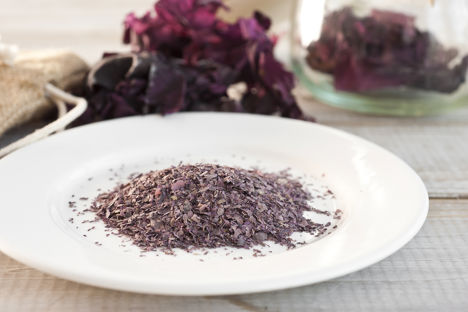
Dulse: the return of a forgotten food
Although officially classified as a forgotten food, the use of dulse (a browny-purple seaweed) is now on the rise. Thanks to Nordic and Japanese cuisines becoming more popular, chefs and home cooks are experimenting with ways to use seaweed – not only in its original form, but also as a powdered flavour enhancer.
Dulse: the return of a forgotten food
Although officially classified as a forgotten food, the use of dulse (a browny-purple seaweed) is now on the rise. Thanks to Nordic and Japanese cuisines becoming more popular, chefs and home cooks are experimenting with ways to use seaweed – not only in its original form, but also as a powdered flavour enhancer.
Dulse (Palmaria Palmata) – so-called because of its finger-like leaves and palm-like shape – is a seaweed officially classified as a 'forgotten food' and is part of the Ark of Taste by Slow Food UK, which aims to preserve and appreciate our culinary heritage. It sits alongside other previously undervalued foods like the Northdown clawnut (a large walnut) Goosnargh cake and Penclawdd cockles. Fresh dulse has surprisingly delicate, savoury notes; whereas when dried, there is a smokiness that gives way to a sweet aftertaste, not a million miles away from liquorice.
Top chefs like Andrew MacKenzie and Brett Graham use dulse as an innovative and flavoursome addition to sauces, emulsions, breads and crusts. AA Gill, the late food critic and seaweed convert, recently talked of Dulse as a 'subtle but bold gob bolster' and 'the most intense source of umami' along with other seaweeds. Like kale, which recently reinvented itself as a fashionable and nutritious snack, dulse has made a comeback. It is now a product that you can pick off the shelves of your local deli, farm shop or M&S. Truly a proud moment for a marine vegetable which has been quietly minding its own business for 1.5 billion years.
So, what is dulse and why is it a food worth remembering? It is a dark browny-purple colour, harvested from late spring through to autumn. It grows up to twelve inches long, off kelp and rocks, found inter-tidally, in cold waters around the world off North America and Europe. It is iron-rich and incorporates all the trace elements, has high mineral (roughly ten times that of land vegetables) and protein content, but crucially is low in fat. With its substantially lower sodium content than gourmet salt (ten percent versus 98%), dulse is an all-round much healthier option with an excellent source of iodine (86.7% of your Daily Reference Intake per serving).
From ancient texts it seems clear that dulse has had its place in history for centuries. Valued as much as garlic or salt since the time of St Columba, in Fergus Kelly’s book on land values, a rock with Dulse on it is equal to ownership of a cow! 'Bo are charraigh thoraigh dia mbentar duileasg no femnach' or 'a cow for a productive rock, from which dulse is cut'.
An early nineteenth century etching by Walter Geikie encapsulates a typical street scene in Edinburgh of a vendor selling 'bawbee pooches' of 'crisp saline' dulse out of wicker creels. Wind the clock on two centuries and you have packets of ‘seaweed thins’ being sold out of sandwich shops and lunch stops, as the perfect tasty nutritious snack for busy people.
More recently seaweed made a comeback as part of the New Nordic Cuisine where gastronomic food tests with dulse proved that it was a better source of umami agents than Japanese kombu. Their tests using dulse dashi to infuse fresh cheese, ice cream and sourdough illustrated that the seaweed is a very successful flavouring agent and 'holds a great promise for novel uses not only in the New Nordic Cuisine but in general'.
In terms of home cooking, dulse can be added in its dried ground form to give flavour and nutrients to everything from seasoning lamb and adding savoury deliciousness to sauces, burgers or stews. Creating rubs, marinades and emulsions, toasting in the oven or pan frying with soy sauce, nuts and seeds, dulse can season slow-cooked roasts or be the solution to a quick, healthy lunch.
Of all the other umami-rich foods such as spring onion, cooked tomato, shiitake mushrooms, prawns, bacon, Parmesan, tuna, oysters and squid, seaweed has more glutamates. These umami-loaded foods can satisfy the palate (you experience the 'fifth taste' on a different bit of your tongue) and, if you get the balance of flavours right, can be the ultimate comfort food.


